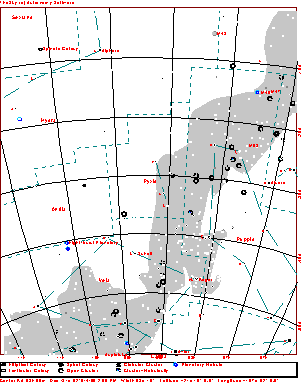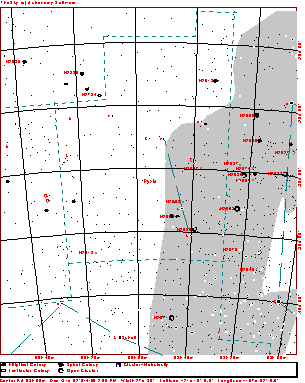
| Home | Deepsky Atlas | TheAstronews | Links | Solar System | ||||||

Hawaiian Astronomical SocietyConstellations: Pyxis -- Compass of Argo Navis |
||||||||||

Click the map for a 916x1149 version of the above. Click here for a map better suited for use in the field.

Click here for a map better suited for use in the field.
 35k JPEG Here is a description of NGC2818 from the 2000 Plus Catalog (with corrections): "8M; 9' diameter; 40-plus 9M and dimmer members in a weakly concentrated mass; see, also, embedded bipolar PL NEB N2818a (12M; 38" diameter; a.k.a. PK 261+8.1) which looks at high power (>300x) like a miniature Dumbbell (M27); find the duo 7° N and a bit E of 2M Lambda VEL, just 1° N of a small knot of three 5-6-7M stars." A remarkable object, because the planetary actually belongs to the cluster, unlike M46, where the planetary is a foreground object. Image by David Malin from the Anglo-Australian Telescope. 35k JPEG Here is a description of NGC2818 from the 2000 Plus Catalog (with corrections): "8M; 9' diameter; 40-plus 9M and dimmer members in a weakly concentrated mass; see, also, embedded bipolar PL NEB N2818a (12M; 38" diameter; a.k.a. PK 261+8.1) which looks at high power (>300x) like a miniature Dumbbell (M27); find the duo 7° N and a bit E of 2M Lambda VEL, just 1° N of a small knot of three 5-6-7M stars." A remarkable object, because the planetary actually belongs to the cluster, unlike M46, where the planetary is a foreground object. Image by David Malin from the Anglo-Australian Telescope.
|
 88k JPEG NGC2627 (Bennett 40) is a mag. 8 open cluster located in western Pyxis, about 40' south-west of Zeta Pyxidis (it's the bright star in the top, left of the digital Sky Survey image). The NGC description reads: quite large, richer and more compressed toward the west, with about 40 stars of magnitude 11 to 13. 88k JPEG NGC2627 (Bennett 40) is a mag. 8 open cluster located in western Pyxis, about 40' south-west of Zeta Pyxidis (it's the bright star in the top, left of the digital Sky Survey image). The NGC description reads: quite large, richer and more compressed toward the west, with about 40 stars of magnitude 11 to 13.
|
If you have any questions about the Hawaiian Astronomical Society
please
(link requires javascript).